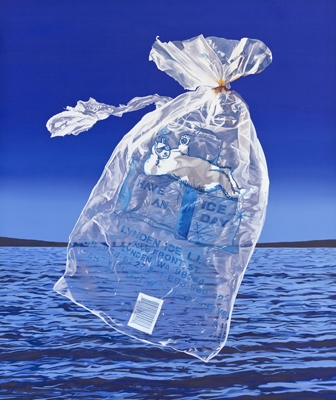STATEMENT

The tenuous boundary between living nature and human encroachment is the primary unifying theme in my artwork.
In my ongoing painting series, Watershed, I take a light-hearted yet subversive approach to the serious subject of ocean degradation, presenting a tongue-in-cheek taxonomy of our new post-consumer creatures of the sea. Influenced by the ideas of Pop artists Claes Oldenburg, Ed Ruscha and Andy Warhol, and the high-contrast light of Edward Hopper, I meticulously paint seascapes in oil and gouache, lovingly crafting beautiful images of conventionally ugly beach cast-offs, and aiming to create provocative visual juxtapositions of form and idea.
The Watershed paintings are inspired by the incongruity of the man-made detritus found washed up on the otherwise pristine shores near my Discovery Bay WA studio; the plastic shards and PETE water bottles, plastic bags, the mismatched running shoes, the foggy plastic water bottles, the throw-away lighters, the frayed lengths of nylon rope, the spent shotgun shells, to name but a few. I collect this local flotsam as it bobs in on the waves from far and near, and with my ear to the sand for a close view, I pose and photograph it on the beach where it strands. The resulting seascape compositions depict the beach trash as monolithic, thereby providing a visual metaphor for the overwhelming magnitude of the issue of marine debris.
As an example, my large-scale oil painting, Have an Ice Day, 2015 (above) depicts a tattered plastic party-ice bag sporting the cartoonish graphic of a polar bear floating in limbo over the sea. The party-ice in this bag has long since vanished, just as the ice cubes illustrated on the bag are melting out from under the sunglass-clad ice-bear as he poignantly waves good-bye; a parting metaphor for the potential of mass extinction in the warming and disappearing habitats of the globe.
For the Sea Stack series, I expand on the themes of my Watershed series, creating six-foot tall oil paintings that depict towers of beach trash, imaginary idols for 21st century plastics culture. Stacking things seems to be an archetypical human compulsion. My Sea Stack paintings are fantasy images of what might be excavated and displayed in antiquities museums, town squares, and along the shores of the future, sadly but humorously representing what we leave behind as the legacy of our Age of Oil and our love affair with throw away plastics.
For the found-object Flash Point sculptures, made from hundreds of burned and unburned wooden matchsticks, driftwood, and miniature scale-model figures, I merge issues of industriousness, overpopulation, and deforestation. Suggesting the exploitative cycle of forest and natural resource depletion, the charming yet ominous Flash Point sculptures imply the imminent risk of explosion and devastation. Oblivious to potential danger, happy swarms of insect-like figures busy themselves with work and recreation, continuing mankind’s ongoing pattern of growth and decay, and expansion and contraction.
Water Shed, a walk-in sculpture installed at Port Angeles Fine Art Center in the watershed area of Washington’s Olympic Mountains, was a house-like structure that I built from a salvaged, burned-out greenhouse as its frame, and by binding PETE water bottles with recycled copper wire to create its siding and roof. All of the hundreds of bottles incorporated in the sculpture were salvaged from local beaches, businesses, individuals, and recycling centers, reusing the materials that we have shed from our consumer culture.
